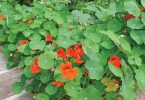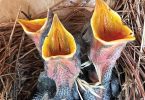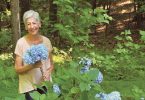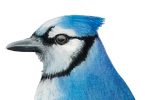By Laura Mahan
May is mountain laurel season here in the Southern Appalachians. This evergreen shrub will catch your eye as you drive up the Blue Ridge Parkway, with its clouds of whitish-pink, inch-wide flowers on gnarly branches with thick, leathery leaves. It is also, of course, the namesake of this magazine, The Laurel of Asheville.

Mountain Laurel
Our mountain laurel has a few other names: ivy, ivybush, calico-bush, spoonwood and lambkill, due to the fact that the foliage, if eaten, is toxic to livestock and humans. The botanical name of mountain laurel is Kalmia latifolia.
A member of the Heath family, which also includes such familiar acid-soil plants as Rhododendron, blueberry and sourwood, Kalmia was named after Swedish-Finnish botanist and explorer Pehr, or Peter, Kalm. Kalm was appointed by the Royal Swedish Academy of Sciences to travel to North America between 1748 and 1751 to find seeds and plants that might prove useful for agriculture or industry. He was befriended by Benjamin Franklin, served as the pastor of a church in NJ and was the first trained scientist to write a description of Niagara Falls.
Take a closer look at a mountain laurel flower. Before they open, the buds are star-shaped domes with ten points around the perimeter. When the flower opens, look inside to see the ten stamens (male parts). They grow perfectly in position so that the anthers (pollen sacs at the tip) are guided and secured under tension into the ten pouches. They are spring-loaded. The opening of the flower creates tension on the filaments so that when a pollinator, usually a bumblebee, lands there, the anthers are jarred loose from the pockets. Presto! The pollinator is bombarded with pollen as the stamens spring up from the pouches. The pollen-laden bee then travels to the next flower and deposits its precious cargo.
Mountain laurel sometimes forms dense, almost impenetrable evergreen patches known as “laurel hells” or “ivy thickets,” particularly on upper slopes and ridges where tall trees are sparse, and is a common ecological partner with the beautiful rosebay rhododendron at higher elevations, the zone of nesting birds such as the Black-throated Blue Warbler and Dark-eyed Junco that seek dark, dense, shaded cover. Because of mountain laurel’s ability to adapt to poor soils and low moisture situations, it can contribute to fires, but it also provides winter food for white-tailed deer and ruffed grouse.
The next time you take a drive up the Parkway, poke your finger into a newly-opened flower and see what happens!
Laura Mahan is owner of The Compleat Naturalist, located in the Historic Biltmore Village. To learn more, visit CompleatNaturalist.com.






